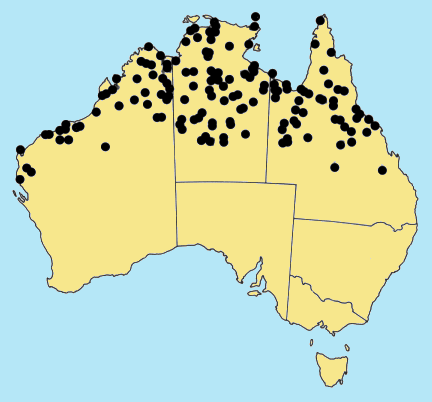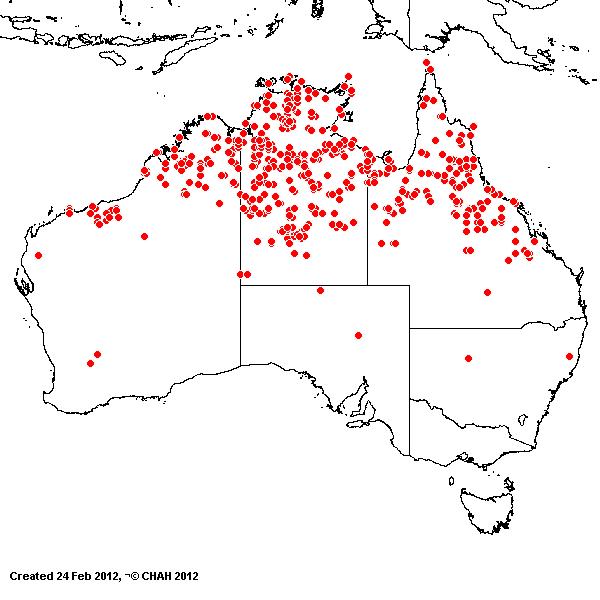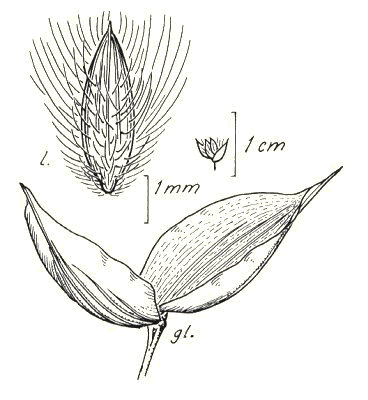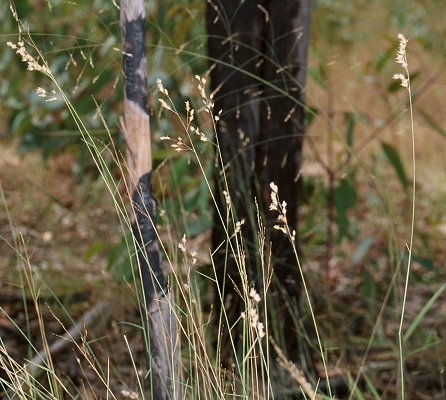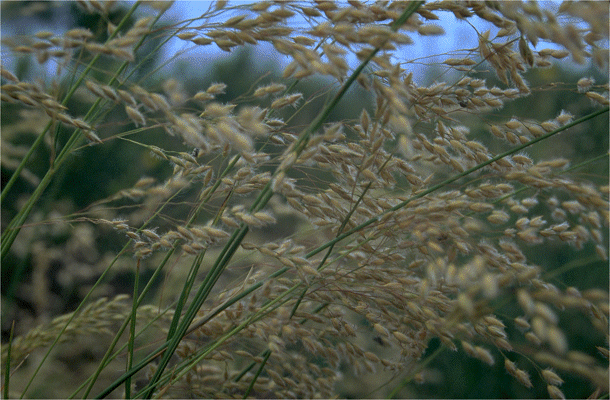Eriachne obtusa R. Br. Prodr. 184
(1810).
Classification. (GPWG 2001) : Subfamily
Micrairoideae. Eriachneae.
Type of Basionym or
Protologue Information: Australia, Carpentaria, Sweers Is.: Brown 6260 (BM holo, CANB, E, K).
Recent synonyms:
E. obtusa var. major, E. major.
Key references
(books and floras): [1810]. R.Brown, Prodromus (184), [1878]
G.Bentham, Flora Australiensis 7 (632), [1952] C.A.Gardner, Flora of
Western Australia 1 Gramineae (51), [1981] M.Lazarides in J.Jessop
(ed)., Flora of Central Australia (441 as E. obtusa var obtusa),
[2002] D.Sharp & B.K.Simon, AusGrass, Grasses of Australia.
Habit.
Perennial. Culms erect, 30–60(–90) cm tall. Mid-culm nodes glabrous or
pubescent. Lateral branches branched. Ligule a fringe of hairs. Leaf-blades
flat or involute, 5–16 cm long, 1–4 mm wide. Leaf-blade surface smooth or
scaberulous or scabrous, glabrous or indumented.
Inflorescence.
Inflorescence compound, a panicle. Panicle elliptic or oblong, dense, 4–7(–13)
cm long, 1–4 cm wide.
Spikelets.
Spikelets pedicelled. Fertile spikelets 2-flowered, both fertile, comprising 2
fertile floret(s), without rachilla extension, ovate, laterally compressed,
3–4.75 mm long.
Glumes.
Glumes similar, thinner than fertile lemma. Lower glume ovate, membranous,
without keels, 5–7 -nerved. Lower glume surface glabrous or indumented. Lower
glume apex muticous or mucronate. Upper glume ovate, 3–4.75 mm long,
membranous, without keels, 7 -nerved. Upper glume surface smooth or scabrous,
glabrous or indumented. Upper glume apex muticous or mucronate.
Florets.
Fertile lemma 3–5 mm long, without keel, 5 -nerved. Lemma surface indumented.
Lemma apex muticous. Palea 2 -nerved. Palea apex entire, muticous. Grain 1.5–2
mm long.
Continental
Distribution: Australasia.
Australian
Distribution: Western Australia, Northern Territory, Queensland.
Western Australia:
Gardner, Fitzgerald, Hall, Dampier. Mueller, Canning, Fortescue, Carnarvon. Northern
Territory: Darwin & Gulf, Victoria River, Barkly Tableland, Central
Australia North. Queensland: Burke, Cook, Gregory North, Leichhardt,
Mitchell, North Kennedy, South Kennedy, Warrego, Port Curtis.
Notes.
Distinguishing characters include wiry branched glabrous culms, awnless
spikelets, florets shorter than glumes with appressed lemma and palea,
grooveless lemmas with ciliate margins, straw-coloured glumes at maturity,
broad strongly compressed caryopsis, and the mostly glabrous callus with a
basal ring of hairs. Considerable variation occurs in the size and form of the
panicle, spikelet dimensions, indumentum on the glumes and foliage, and to a
lesser extent in the shape of the glumes. Eriachne obtusa closely
resembles E. mucronata (mesophytic form). However, in E. mucronata
the florets are often slightly longer than the glumes (not slightly shorter).
The lemmas are abruptly contracted at the apex and mucronate or aristulate (not
tapered and muticous), and have hyaline, glabrous margins (not entirely
membranous and ciliate on the margins). The callus is entirely bearded (not
mostly glabrous), and the glumes are broadly ovate-elliptic, obtuse, mucronate
and 11–13-nerved (usually ovate, acuminate, muticous and 5–7-nerved in E.
obtusa).
Native.
N of 24ºS in Qld, N.T. and W.A. (predominantly N of the Tropic of Capricorn);
also in Irian Barat. A common, widespread and adaptable species, growing in
skeletal, shallow or deep soils of fine (clays and clayey loams), intermediate
(podsols and red earths), or coarse (sands) texture, in association with
sandstone, laterite, basalt, quartzite, granite and calcareous rocks. Habitats
include sandplains, coastal sand dunes, salt pans and marshes, lagoons,
depressions and swamps, coastal "pindan", rocky undulating plateaux,
gorge floors, the alluvial banks, beds and levees of streams, seepage slopes,
and the slopes of hills, ridges and mesas. Over its distribution range, the
species flowers and fruits in all seasons, but most commonly Dec.-Aug. (summer
to winter).
